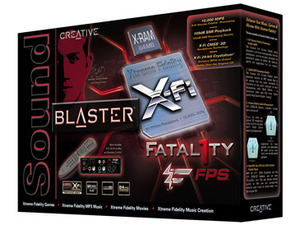
Is it any good?
In a word, yes. The X-Fi Fatal1ty FPS offers a very high level of audio fidelity and a superb set of features. The only card in the X-Fi range to offer more is the Elite Pro version, which has higher quality components, an external module and a considerable price hike. For most gamers, the Fatal1ty FPS should be the optimum choice.Audio fidelity: Creative Labs make great claims regarding the X-Fi’s sound quality, and our testing shows that these are not without justification. We have to admit to being surprised by the clarity and detail from this card, and have no hesitation recommending it to anyone who is serious about their sound quality, especially so if you are upgrading from integrated audio.
The raw electric specifications from the X-Fi are incredible, and really make an audible difference over basic motherboard sound. Even Azalia, which is a little better than standard integrated audio, only supports 30 voices in-game, whilst the X-Fi can support 128 with almost no hit, using X-RAM.
The featureset: Features such as the Crystalizer and surround sound headphones have some great uses. Indeed, many gamers might feel that the latter is justification enough for the purchase. The stereo sound spacialiser is of limited use, however, if you want to preserve the integrity of the sound you're listening to.
The software is best it's ever been, offering a lot of flexibility in setup, as well as some genuinely useful options.
Unfortunately, until games start properly supporting the X-Fi’s powerful features, such as the on-board X-RAM, its benefits will go unnoticed. However, those games that do fully utilise the cards resources should see significant improvements in audio performance and reduced CPU overhead, as well as better audio quality.
We feel sure that, like its predecessors, the X-Fi range of sound cards will be the standard against which all others will be judged.


The Value Proposition:
As we have seen, the performance of the Sound Blaster X-Fi Fatal1ty FPS is top notch. It is feature-rich and is a genuine step forward in PC audio - if you are in the market for a top quality soundcard that excels in all areas, then the X-Fi Fatal1ty FPS comes highly recommended.However, whether it represents value for money depends on who you are and what your needs are. The Fatal1ty version of the X-Fi card costs $277 from NewEgg and £163 from Scan. This compares to "free" for an on-board motherboard solution like Intel's Azalia, and around £45 for an Audigy-series card. The X-Fi Xtreme Music is £85 - half the price of the Fatal1ty FPS - and while it still supports EAX 5.0, it comes with neither X-RAM nor the I/O drive / remote control.
As we have shown, the X-RAM is a feature worth having if you take your gaming seriously, providing future titles continue to support it. The remote control is good for changing EAX and Crystalizer settings in-game and if you also use your PC for watching movies, but otherwise you are paying a hefty premium just to have some extra inputs on the front of your machine.
The featureset, audio fidelity, headphone processing and the potential for enhanced game audio in the future make this a great buy for gamers who are serious about their obsession, and the Sound Blaster X-Fi Fatal1ty FPS should be at the heart of all ultimate money-no-object gaming rigs.
However, if you already have a decent soundcard, the decision is a little more difficult. If your current soundcard is an Audigy 2, then upgrading on grounds of audio quality alone becomes a questionably expensive exercise. You may believe the extra features make the purchase worthwhile, but £163 is a lot of cash to pay for them. However, if you do decide to stump up the cash, we guarantee you won't be disappointed.
If you're using on-board sound for anything more than casual gaming, we suggest you consider upgrading to an add-in soundcard. Creative's Audigy range is a good entry level, but as we've said, if you've got the budget, we'd go for a X-Fi Fatal1ty FPS every time.

Sound Blaster X-Fi Fatal1ty FPS
[i]Editors note: we originally suggested in this review that the surround sound headphone effect was based on an implementation of Dolby Headphone technology. This is not true, and the relevant sections have been updated to that effect. The surround sound headphone effect is entirely proprietory Creative technology, and, in our opinion, far surpasses the quality of the Dolby standard. We apologise for any confusion we may have initially caused.)

MSI MPG Velox 100R Chassis Review
October 14 2021 | 15:04








Want to comment? Please log in.